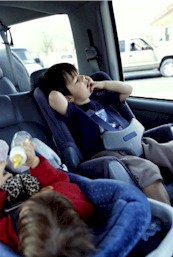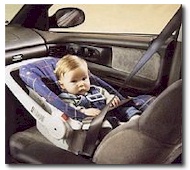|
The Big Picture
Statistics, Recalls and Common Mistakes
|
 |
 |
NEVER
place a child seat in front
of an airbag. |
|
Children at risk
Motor vehicle crashes are the single largest cause
of child fatalities in the country, responsible for more than
1,800 deaths of youngsters age 14 and under each year, according
to the National Safe Kids Campaign. The Washington D.C.-based
child safety advocacy group estimates another 280,000-plus children
are injured each year while riding in vehicles.
Yet, safety tests show the risk of injury or death
for a child can be reduced as much as 70 percent if an unrestrained
child is put into a child safety seat.
Problems with child seat use
Parents may feel that by buying a child seat and putting
it in a car that their child is safe, but in reality there's a lot more to it than that.
A federal government study reported 80 percent
of child safety seats are not used properly. National Safe Kids,
which checked more than 17,000 child safety seats at nationwide
checkups, said it found the figure to be closer
to 85 percent.
Common child seat mistakes
A government study found the biggest problem with child seats
was improper use of locking clips. Follow instructions that come
with the child seat, as well as those that come with your vehicle,
to see if you need to use the clips and that you're using them
correctly.
NHTSA (National Highway Traffic & Safety
Administration) also found that more than half of child
seats had harness retainer clips that weren't used correctly.
Again, follow instructions that accompany the child seat. In general,
harness retainer clips should be placed at the level of your child's
armpits, according to National Safe Kids.
More mistakes
Ranking third in the NHTSA study of problems was use of harness
straps. They should not be loose. According to National Safe Kids,
you shouldn't be able to fit more than one of your fingers between
a harness strap and your child's collarbone.
In addition, the harness straps should not be
twisted. And make sure they're routed correctly through the proper
slots on the seat.
Another problem cited by NHTSA was use of the
vehicle safety belts. The owner's manual for your vehicle details
proper seat belt use. Be sure the belt used with the child seat
is firmly locked in its connection, routed correctly with the
child seat and holds the seat firmly in place. You should not
be able to wiggle the child seat from side to side or pull it
forward.
Further down in the list of problems, but still
accounting for ten percent of the child seat mistakes reported
by NHTSA is positioning of a child seat in the wrong direction
inside the car. Rear-facing child seats should only be positioned
to face rearward; forward-facing seats should only face forward.
In addition, National Safe Kids notes you should
be sure to keep a rear-facing child seat reclined at a 45-degree
angle, so it cradles the baby's head.
Consequences of improper child seat use
Some child seat mistakes clearly are dangerous—for example,
positioning a child seat the wrong way inside a car or putting
a child seat of any sort in front of an active frontal airbag.
But studies haven't yet pinpointed how dangerous
some of the other child seat misuses are, things like not using
a locking clip correctly or not having the child seat secured
as tightly as it could be with the vehicle safety belt.
Because we don't know, as a society, which of these
problems will be life-threatening, it's important that we make
an effort to learn proper child seat use.
Lots to learn
It's not that parents and caregivers aren't paying attention or
don't care. They're dealing with more complicated child seats
today. Many child seats have recalls, too, that often can go unnoticed
by child seat owners. One source for recall and other child seat
information is the Internet; many private organizations as well
as government agencies have Web pages to help parents wade
through the daunting amount of data in circulation.
Below are a few of the important Internet sites dedicated
to promoting child safety in automobiles via child seats. Packed
with press releases, recalls, safety news and more, these sites
are great places to begin gathering information about providing
the children in your charge with the safest ride possible.

Britax Child Safety, Inc.
http://www.childseat.com/
Britax is one of the biggest names in child seats, with nearly
20 percent of the world's child seat sales. The site includes
a list of car seat “do's and don'ts,” tips for securing
children, what fits your child, and frequently asked questions
about child seats.
National Highway Traffic Safety Administration
http://www.nhtsa.dot.gov/people/injury/childps/
This site includes links to the new Federal Motor Vehicle Safety
Standards for child seats, a form for reporting problems with
a safety seat, a list of safety training programs, and even a
state-by state list of individuals who have attended the programs
and may be of help.
National SAFE KIDS Campaign
http://www.safekids.org
The National SAFE KIDS Campaign is the first and only national
organization dedicated to the prevention of unintentional childhood
injury—the number-one killer of children ages 14 and under.
The site is the home of the SAFE KIDS BUCKLE UP, a national campaign
to increase awareness about child seat safety. This site is updated
frequently and includes a calendar of Car Seat Check Up events
around the U.S.
National Safety Council
http://www.nsc.org
This site contains a wealth of information on child seats, child
safety, and safety in general. In May 1999 the America Buckles
Up Children campaign was launched, and June was National Safety
Month.
Safe Ride Helpline Online
http://www.carseat.org/
The online site of SafetyBeltSafe U.S.A., a nonprofit organization
dedicated to child safety. The site includes recalls (including
ways to identify your seat, with photos), classes, technical information
on seats, frequently asked questions, and links to other sites.
Safe Ride News
http://www.saferidenews.com
With a tagline of “Information for Parents, Safety Advocates,
and Health Professionals,” Safe Ride News contains a broad
range of information, from selecting child seats to choosing the
“perfect” car (safety-wise, that is). There are also
technical bulletins, child seat recalls and hospital issues.

The vehicles in which the seats are installed
aren't standardized, either. Some have flat seat cushions, for
example, that help make a child seat stable while others have
contoured bucket seats that make child seat stability more difficult.
Where the seat belt connectors are in a vehicle can help or hinder
proper child seat positioning.
Safety falls off as children age
Efforts by child safety advocates seem to be
working to get the nation's youngest children into child seats.
But statistics show that use of proper restraints declines as
a child ages. And you'd be surprised to learn how few laws govern
auto safety for children once they leave child safety seats—or
how much the laws vary from state to state.
According to a NHTSA phone survey of U.S. parents,
96 percent of newborns travel in child seats all the time, but
by age 3, the figure is down to 75 percent. By age 5, just 17
percent of children are in child seats all the time, the survey
indicated.
Still, child seats—be they for newborns,
toddlers or older children—continue to be the most effective
way to protect a child in a vehicle crash. And it almost goes
without saying that once a youngster is out of child seats, he
or she should always wear seat belts and sit in the back seat,
where it is much safer. One of the main problems is keeping kids
buckled up as they get older.
- Be aware of recalls
- Register your child seat:
Note that manufacturers of child seats provide a registration
form with their child seats built as of March 1993. By completing and returning the form, typically
soon after purchase, a buyer provides contact information for
the manufacturer to use in the event of a recall. Manufacturers
also have agreed to maintain names and addresses of child seat
purchasers that they had in their files from before March 1993.
Other ways to stay in touch
In case you missed out on those registration opportunities, NHTSA's
Web site also provides a child seat safety registration form you
can fill out and submit to NHTSA that allows the agency to provide
your contact information to the seat manufacturer.
NHTSA maintains a toll-free number for further
questions. 1-800-424-9393.
And don't hesitate to inform NHTSA if you have
noticed a problem with your child seats. The Web site includes
a child seat questionnaire form where you can report defects.

Learn More...
Auto
Insurance Overview | Understanding The
Basics | Coverage Options
Safety & Tips | Choosing
A Policy | Filing A Claim | Car
Rentals & Motorcycles

Please Note: The
information contained in this Web site is provided solely as a source of
general information and resource. It is a not a statement of
contract and coverage may not apply in all areas or circumstances. For a complete
description of coverages, always read the insurance policy, including
all endorsements.
|



